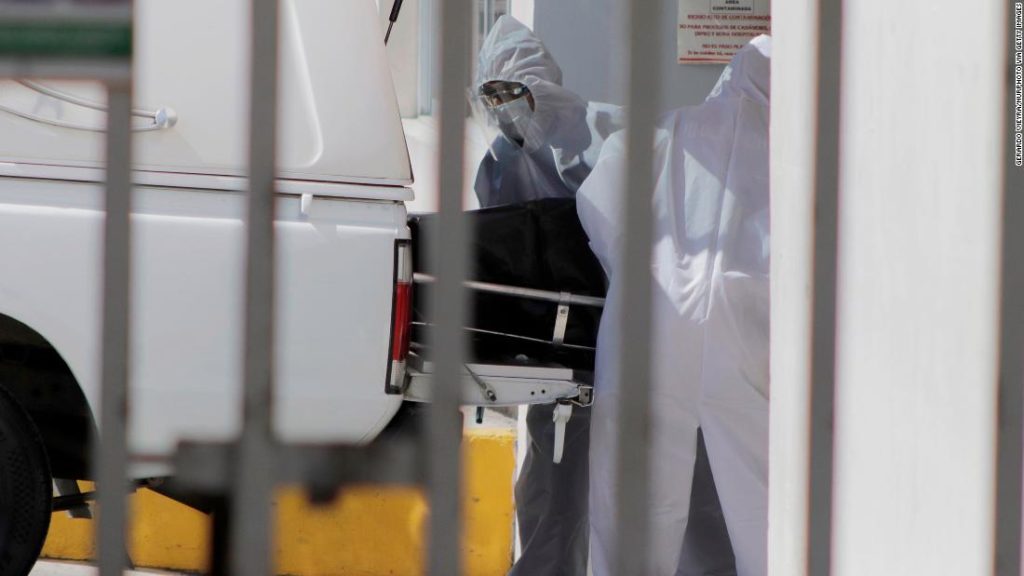
Health officials spent most of October warning that the country was sliding backwards, registering spikes in case and death counts from the virus in many regions.
Though Mexico has never really gotten its virus outbreak under control, newly confirmed cases and deaths had largely plateaued by the summer. That changed with the season.
From September 21 through a recent peak on November 12, the 7-day moving average of new cases jumped nearly 50 percent.
The more than 7,600 daily cases recorded on November 11 marked one of the highest since the worst days of the summer, after the country’s initial shutdown had lifted.
Compared to the US or Europe, that number might seem low. But Mexico has one of the lowest testing rates of any major country around the world. Tests are often expensive and difficult to come by.
Because the government does not test widely across the population, the actual number of people who contract Covid-19 on a daily basis is likely far higher than the country’s numbers reflect, a fact the Mexican government has acknowledged.
During the recent spike, the government has raised official alert levels in multiple states, a clear sign that authorities are concerned about a worsening pandemic.
Few places better embody the fallout of the sudden, deadly spike, than the northern state of Durango.
“It’s not fair”
It was just 11 months ago that famed local singer José Ángel Medina Soto was serenading crowds in his native state of Durango, as the front man of the band Patrulla 81.
A January video on the group’s Facebook page shows fans packed tightly together in the Metrópoli Premier music venue in Durango, unaware of the tragic pandemic that would unfold before the year was out.
Medina Soto got sick in the middle of October, just after his 61st birthday.
He was living in neighboring Chihuahua state, but frequently traveled back and forth. He had stopped touring when the country shut down, and was exploring ways to keep his music career going. His daughter, who lives in Durango, said that at first, everyone thought he’d be fine. The doctors were treating it like a cold.
But within days, he found it difficult to breathe. Four hospitals rejected him, saying they were already over capacity. A fifth took him in, where he died two weeks later.
“It’s not fair,” said his daughter, Alma Medina. “He had so many plans for his life.”
The revered singer’s picture now hangs along a guardrail blocking entry to a central plaza in Durango City, both a vigil and a reminder that the pandemic still looms large.
Durango and Chihuahua’s cautionary tale
In sparsely populated Durango, cases have exploded recently. The total number has more than doubled since September 21, and they continue to rise.
The bordering state of Chihuahua matched that increase during the same time period, also more than doubling its case count.
Over the past several weeks, hospitals in both states have routinely reported occupation levels at or near capacity. A mobile hospital was built in Chihuahua at the end of October to try and help accommodate the surge.
The pair of states have become cautionary tales for the rest of the country. These were places where for months it seemed the virus was largely under control. Seemingly without warning, that suddenly changed.
Officials say what’s driving the spike is persistent social gatherings, despite government warnings to avoid them. “Parties continue, family and social gatherings kept going where people could easily congregate,” Sergio González Romero, the health secretary in Durango, told CNN. “Rising infections are the direct consequence.”
The monitoring of young people up to age 30 by González Romero’s government, along with the rise in sick elderly patients, suggests Mexico’s youth are contracting the disease, recovering, and spreading it, while infected parents and grandparents may not survive.
Rubén López Gallegos, 63, lost his life to coronavirus in Durango in October. His family isn’t sure how he contracted the disease.
“This situation makes me mad,” said his daughter, Maria Cristina López Soto. “I have stopped speaking to people, to friends, because they don’t care [about the virus]. My family has gone through something where we’ll never be the same. It marks you.”
As a result of the spikes, both Chihuahua and Durango recently regressed back into a Red Alert level, an official government classification where restrictions on movement and the economy are tightest.
In Durango, all non-essential businesses are closed until at least next week. Alcohol sales are banned and traveling on public transportation is prohibited at certain times.
In neighboring Chihuahua, a two-week curfew on non-essential businesses went into effect on November 5th to try and slow the virus’ spread. It is expected to remain in its Red Alert level for the immediate future.
In all, there are multiple other states across Mexico that have upped their alert levels and imposed harsher restrictions in recent weeks.
In Mexico City, the worst affected area of the country, the city’s mayor, Claudia Sheinbaum, has repeatedly said she may be forced to put the city back on Red Alert.
New cases and subsequent hospitalizations there have risen as of late, and city officials have launched a public awareness campaign urging citizens to comply with sanitary measures in order to avoid imposing further restrictions.
Sheinbaum herself was diagnosed with the virus back in October.
Data from the University of Miami’s Covid-19 Observatory, which tracks population mobility in each Mexican state, shows that people have been steadily increasing their movement within their state throughout the year.
Restrictions easing, good news for some
Despite the recent spike across the country, the most recent data shows new cases are generally, if slowly, beginning to wane, national health officials say.
As a result, tighter restrictions, such as curfews currently in place in some areas around the country like Chihuahua, may soon be loosened.
It’s welcome news for some business owners in Durango.
Miguel Camacho owns six restaurants across the city. Three have shut down and he has laid off more than 60 percent of his staff.
“It hurts me a lot to see some of them on the streets, looking for work,” said Camacho, describing a recent encounter with a former employee. “I’ve seen some cleaning windshields at traffic lights.”
Though Camacho says he understands putting people’s health first, the current restrictions are unsustainable.
“With these restrictive hours and no alcohol sales, we are worse off now than in the beginning of the pandemic,” he told CNN.
CNN spoke to several people in line at a pawn shop in Durango who were there to sell some personal items, specifically because of tough times during the pandemic.
What comes next?
Restrictions or not, we still don’t have an exact idea of how bad Mexico’s pandemic truly is.
The vast majority of global health experts disagree with that approach, saying more testing is essential to curbing the virus’ spread. Even with inadequate testing, the country has still managed to register one of the highest overall case counts in the world.
Mexico’s mortality rate, the number of people who test positive for the virus and then die, stands close to 10 percent.
That is nearly five times greater than the figure for the US and the highest in the world among the 20 countries most affected by Covid-19, according to data from Johns Hopkins University.
The looming threat, health experts tell CNN, is what’s to come as restrictions loosen amid the approaching holiday season.
In Mexican tradition, there are numerous cultural occasions, such as the Virgen de Guadalupe festival, that draw families and friends together often through Christmas and the end of the year.
“We’re afraid of another wave,” said Durango Health Secretary González Romero. “Because we don’t know how big it could be.”
You may also like
-
UK coronavirus variant has been reported in 86 countries, WHO says
-
NASA technology can help save whale sharks says Australian marine biologist and ECOCEAN founder, Brad Norman
-
California Twentynine Palms: Explosives are missing from the nation’s largest Marine Corps base and an investigation is underway
-
Trump unhappy with his impeachment attorney’s performance, sources say
-
Lunar New Year 2021: Ushering in the Year of the Ox

